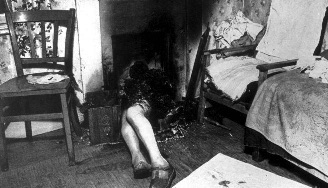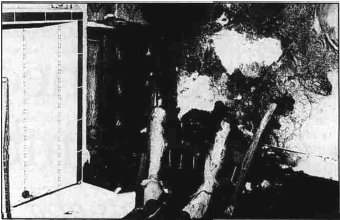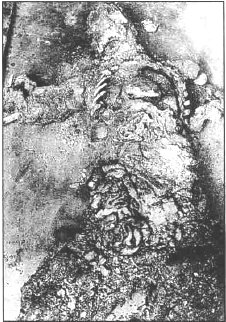Spontaneous combustion is scientifically defined as the  ignition of any chemical product or material that is not initiated by direct application of a flame or direct source of ignition.
ignition of any chemical product or material that is not initiated by direct application of a flame or direct source of ignition.
Spontaneous Human Combustion is the proposed phenomenon whereby human beings spontaneously combust without any external source of ignition, often burning away most of the body, yet leaving surrounding materials unburned.
Can human beings spontaneously combust?
To answer this we need to look at what combustion is. Under normal circumstances there are three requirements for combustion; often called the fire triangle:
- An oxidising agent
There are many oxidising agents other than oxygen; however, with the case of domestic fires it is oxygen from the air that acts as the oxidiser. - A fuel
The fuel is the substance that reacts with the oxidizing agent during combustion. - A heat source
This could be a spark, a flame, or a hot item such as a cigarette, burning coal, or the bar of an electric fire. This is what ignites the mixture of fuel and oxidizing agent.
Chemists have studied combustion in great detail because of the need to understand chemical hazards, and have shown that spontaneous combustion will only occur once a substance has reached a certain temperature; known as its ignition point. Spontaneous combustion occurs at the ignition point without the need for a heat source in a special class of reactions:
Many compounds are known to undergo Hypergolic reactions, which means that they will ignite or explode spontaneously on contact with an oxidising agent. Pyrophoricity is a special case of hypergolic reaction where the oxidising agent is (atmospheric) oxygen. Although there are some pyrophoric liquids and gases, most pyrophoric materials are metals.
The problem with this class of reactions and Spontaneous Human Combustion is that no pyrophoric compounds exist in the human body, nor is there an oxidising agent present. So it seems very unlikely, if not impossible, for human beings to combust spontaneously. A few alternative explanations have been suggested for an internal source of spontaneous combustion, such as Larry Arnold's "Pyroton Particles", but such explanations seem to be invented in order to match the theory rather than based on any evidence.
Although Spontaneous Human Combustion proponents believe that it involves an internal source of combustion, all accounts of burned bodies show that burning occurred from the outside in; many internal organs actually survive the burning, and in no cases are the internal organs burned more badly than the outside of the body.
This means that in cases of human combustion, an external source of ignition, a heat source, is required; which means that spontaneous combustion does not occur in human beings.
If we can not combust spontaneously, what is going on?
Spontaneous Human Combustion has probably been thought to exist because of the fact that bodies have been found where the torso has burned away completely, yet extremities, arms and legs, are left behind unburned. There's often no obvious source of ignition and as surrounding furniture etc. is often undamaged, this can create the illusion that the body had burned from the inside out. This can lead those who are unaccustomed to investigating fire deaths jumping to false conclusions simply because they do not understand the dynamics of the phenomenon.
Indeed there are many sources of information which deal with Spontaneous Human Combustion and various explanations for the phenomenon have been postulated; however, most of these are unscientific. To get a truer perspective on Spontaneous Human Combustion we need to look at the professionals' reports. Professionals such as forensic pathologists.
The truth is that there are no official, professional reports of any case of a fire death where spontaneous combustion (internal combustion without a heat source) has been reported as the cause.
Examples of Spontaneous Human Combustion:

The reason that extremities are often left behind is because of the temperature gradient present in the burning body. Heat rises, and flames easily travel upwards. In a body, which does not easily support combustion itself, flames do not easily move downwards or even laterally.
To illustrate this point, Joe Nickell gives the following analogy:
"In your mind, strike a kitchen match. Having done so, take your other hand and put it under the fire. Safe? Yes. Put it beside the flame, you're still okay. But put your hand over the fire and what happens? You're in serious trouble. Now, strike another match and point the match upwards. What happens? The fire has nothing to consume and burns off the tip of the match and goes out. If you hold the match level, what happens? It may travel sideways until it reaches your fingers; it may also go out. If you tip the match downwards, you'll have no trouble keeping the fire going, you'll burn the match and probably burn your fingers."
 It's often thought that total destruction of the torso occurs in these cases. This is not actually true; the internal organs often survive. Again, this is because of the temperature gradient and the insulating properties of internal fluids which protect the organs from the high temperatures close by.
It's often thought that total destruction of the torso occurs in these cases. This is not actually true; the internal organs often survive. Again, this is because of the temperature gradient and the insulating properties of internal fluids which protect the organs from the high temperatures close by.
The image on the right shows a burned corpse where the heart and intestines have survived intact.
Even in cases as severe as this, forensic experts can often determine the cause of death; be it a fall, heart-attack, or even an attempt to cover up a murder. By far, the most common cause of the burning is ignition by cigarettes. Alcohol has also been implicated; especially in the 19th century when it was believed that drinking too much alcohol could cause human flesh to become highly inflammable. This is now known not to be true. If alcohol is involved, it is more likely to be so in the role of making people more likely to fall asleep whilst smoking, or more likely to fall over into a fire place or onto a source of ignition such as a lamp; and of course, less likely to wake up should such an event occur.
Other causes include people having heart-attacks or strokes whilst smoking. Most victims of alleged Spontaneous Human Combustion are elderly and/or infirm which also adds the complication that if they set their clothing on fire, it would be difficult to deal with it should they become aware.
The wick effect
The human body is known to be difficult to ignite, and it does not readily support combustion on its own. What can happen however, is if a body is ignited whilst clothed, the body fat can melt and be absorbed into the clothing that remains and this fat-soaked clothing acts like a wick, burning in a similar fashion to a candle, although an inside-out candle.
"The liquefied [body] fat of the subcutaneous layer can soak into the clothing, causing it to act like a wick which maintains the fire. Only this mechanism can explain the most severe combustions which are observed in persons who, for example, fall asleep whilst smoking" (Prokop 1960).
It was demonstrated in 1998 on BBC 1's QED programme. A dead pig, which was chosen as pigs have a similar fat content to humans, was wrapped in cloth and set alight. It burned for five hours before the experiment was ended, and the fire largely consumed the pig’s body, including its bones, yet there was little heat damage to other items that had been placed in the room with it.
The fire produced by the wick effect is not a blaze; it's more of a slow-burning smoldering. It gets very hot locally, possibly up to 500oC (note: the 2,000+oC temperatures that some claim are needed to burn a body are not required), but it does not produce huge flames that could set other things alight. This is the reason why the burning stays localised. Also once the fat has been used up, the ash produced acts as an insulator for whatever was touching the corpse - such as the chair it is in. This too prevents other items igniting as the burning wanes.
Of course if other things were to ignite and the whole room went up in flames, it would just look like an ordinary house fire and no one would be looking at it as a case of Spontaneous Human Combustion.
The wick effect is most likely the true explanation for the way the body burns after ignition. It should be pointed out though, that in the QED experiment, petrol was used to ignite the pig's corpse. This is because corpses, pigs' or humans', are not easy to ignite. This leaves us with the most problematic area in explaining apparent cases of SHC: how the bodies ignite in the first place.
Ignition and wick-effect burning
Cases of claimed SHC are rare which suggests that the conditions necessary for wick-effect burning to occur are also rare. The most obvious requirement for a body to be set alight is that the person would have to be dead or greatly incapacitated; a heart attack, stroke, or severe inebriation being obvious candidates.
Cigarettes, or other tobacco and related products, are often cited as the initial cause of ignition. The problem with this is that cigarette ends, although very hot, do not set light to flesh; they can burn through skin but are extinguished in the process. Cigarettes, however, do readily set light to inflammable clothing and furniture. Whether cigarettes or some other source of ignition, the source is external.
The vast majority of fires that begin this way will spread and become a normal house fire. For a case to be described as SHC, the fire has to stay localised to the body. This is where the wick-effect comes into play. If body fat starts to melt and is absorbed by some clothing or sinks into the chair's stuffing, the wick-effect takes over. This means that instead of large flames being produced which could spread the fire, localised burning takes place with small, hot flames which are fuelled as more fat melts as the body burns.
As long as the body is not too close to surrounding objects, the burning will not spread easily. Even newspapers, which burn readily if a flame is applied, require very high temperatures before they will combust spontaneously.
Lastly, as the body fat is used up the flames start to die away. The item that the body is sitting in or lying on is prevented from burning further by the insulating soot and ash that was produced in the fire.
Summary of requirements:
- A dead or incapacitated individual;
- a source of ignition;
- inflammable clothing or furniture;
- body fat melting;
- a potential wick such as clothing or furniture stuffing;
- enough isolation from surrounding objects to prevent direct ignition of them;
- the production of insulating soot and ash to prevent the fire burning further once the fat has burned off.
For a burning case to look like SHC, all of the above conditions need to be satisfied. This is probably what makes these cases so rare.
Conclusion
Spontaneous Human Combustion as a phenomenon itself does not exist. It is most likely used as an explanation for deaths involving burning which occur under very unusual circumstances. Although it may seem impossible for a body to burn in a chair and leave most of the surrounding area untouched, the deaths can be explained without the need for fantastical theories.
Further reading:
An examination of the Phyllis Newcombe case by the Dutch Skeptics: Phyllis Newcombe.
